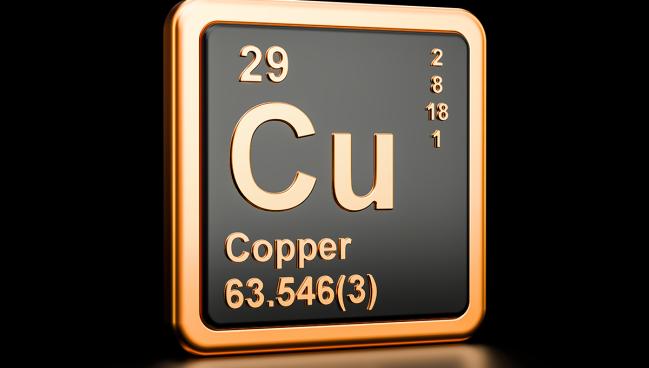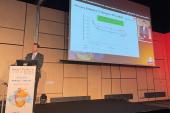Could Copper Chelation Benefit HFrEF? TRACER-HF Offers Mixed Clues
Despite some COVID-19 setbacks in this phase IIb dose-finding study of trientine HCL, the PI thinks it’s worth moving forward.

PRAGUE, Czechia—A nearly 40-year-old agent used to remove copper from the body in Wilson’s disease may have a role to play in treating heart failure with reduced ejection fraction (HFrEF), according to the TRACER-HF trial. Although the trial ultimately missed its primary endpoint, investigators believe there are promising signs that the drug, trientine HCL, warrants additional study.
The dose-finding, phase IIb trial, was launched in early 2020. It faced numerous hurdles due to the COVID-19 pandemic, ultimately shifting entirely to China, where new challenges arose. By the time follow-up was complete, the 300-mg dose of trientine HCL, when added to usual care, significantly reduced NT-proBNP (the primary endpoint) at 4 and 8 weeks, but not at 12 weeks.
Trientine HCL is an oral chelation agent approved back in the mid-1980s to treat the abnormal copper accumulation that occurs in the brain, liver, and cornea in Wilson’s disease—a rare, autosomal recessive disorder—for patients unable to take penicillamine. In normal human physiology, copper plays an important role by promoting iron and zinc uptake and scavenging oxygen free radicals, among other functions. Imbalances in copper metabolisms have been linked to developmental problems with the heart and central nervous system as well as liver dysfunction, and they can also affect lipid metabolism and inflammation.
According to James L. Januzzi Jr, MD (Massachusetts General Hospital, Boston), who presented TRACER-HF here at the European Society of Cardiology Heart Failure 2023 Congress, preclinical studies have suggested that at low doses the drug acts as a “copper chaperone,” restoring normal intracellular copper concentrations and promoting reverse cardiac remodeling in HFrEF.
TRACER-HF
For this dose-finding study, conducted at 27 sites in North America and China, 190 patients were enrolled and equally assigned to a placebo or to a 50 mg, 150 mg, and 300 mg dose of trientine HCL. Twenty percent of the study cohort was female, and as a result of the shift to China, 91% were of Asian descent. Mean LVEF was 30%, and most patients were in NYHA class II HF, with just 23% in NYHA class III.
Use of guideline-directed medical therapy, noted Januzzi, was excellent. Over 95% of patients were on a beta-blocker and an ARNI/ACE inhibitor/ARB, 86.8% were on an mineralocorticoid receptor antagonist, and 38.4% were on an SGLT2 inhibitor at baseline.
For the primary endpoint of change in NT-proBNP, the 300-mg dose emerged as the clear winner, demonstrating a statistically significant 18% drop versus placebo at week 4 and a 21% drop at week 8.
By week 12, however, peptide levels were nearly identical between groups.
Across a range of secondary endpoints, including LV volumes, 6-minute walk test, and quality-of-life scores, all showed a dose-dependent improvement favoring the 300-mg dose.
While investigators had hoped to see the positive effects across all study time points, there are many reasons to think that COVID-19 lockdowns and concurrent infections may have muddied the waters for the primary analysis at 12 weeks, Januzzi said.
“The trial certainly faced hurdles given the COVID pandemic,” Januzzi told TCTMD. “First domestically in the United States and then when we switched over to China, things were going along quite smoothly [but] right at the end of 2021 with the end of ‘Zero COVID’ there was an explosion of COVID. In most cases patients that were affected did not get tested, so we did not know who did or didn’t have the infection at the time. That all said, if you look at all of the mechanistic endpoints, they point in a positive direction.”
What’s important to keep in mind, he continued, is that this was “a phase II trial looking for a dose and we found that dose.”
The treatment also was well tolerated with both blood pressure and heart rate not affected by trientine HCL at any dose. Copper and iron concentrations also did not differ across treatment groups.
This, in theory, could be additive to the standard heart failure tools that we already use without fear of hypotension or worsening kidney function. James L. Januzzi Jr
In an intriguing finding that warrants further exploration, he said, the benefits of trientine HCL were most marked in patients with the lowest ejection fractions at baseline. That patient group, Januzzi noted, “has been put into everyone’s consciousness because of recent data with omecamtiv [mecarbil] being more effective in this population as well.”
In terms of next steps, Januzzi floated the possibility that regulators might be willing to move ahead with a phase III trial without needing a do-over with phase II, simply because the safety of the agent is already well-established and the signals at early time points, prior to the confusion sowed by surging COVID-19, may be reassuring enough to move forward.
In other trials, agents that have safely reduced NT-proBNP while also having a positive impact on the secondary markers studied here, have often gone on to prove beneficial against clinical endpoints, he noted. Moreover, the safety profile of this agent is worth emphasizing, said Januzzi. “This drug, despite a very aggressive background of medical therapy, caused no untoward side effects with respect to blood pressure or heart rate, which is frequently the thing that limits our ability to manage patients beyond quadruple therapy in HFrEF. So this, in theory, could be additive to the standard heart failure tools that we already use without fear of hypotension or worsening kidney function, which is something that we worry about.”
During the panel discussion, moderators pressed Januzzi to explain what might account for the complete obliteration by week 12 of the benefits that had been seen at week 8.
“We’ve been asking ourselves that question and if I had an answer I’d be able to tell you, but I would point out that with 91% of the study population enrolled in China with a substantial percentage of these finishing their follow-up right at the time of the massive surge in COVID-19 that occurred in November or December, it is plausible that there’s something to that and we just simply do not know,” he explained.
TRACER-HF is not the only trial exploring a role for this agent in heart failure. A British trial, called TEMPEST, is testing the drug in hypertrophic cardiomyopathy and according to trial information online, has almost completed enrollment. Whether TRACER-HF’s mixed results influence TEMPEST’s progress remains to be seen: investigators for the trial did not respond to request for an interview.
Shelley Wood was the Editor-in-Chief of TCTMD and the Editorial Director at the Cardiovascular Research Foundation (CRF) from October 2015…
Read Full BioSources
Januzzi Jr JL. A Randomized, double-blind, placebo-controlled phase 2a study to evaluate the effects of trientine-HCL in patients with heart failure and reduced ejection fraction: the TRACER-HF trial. Presented at ESC-HF 2023. May 20, 2023. Prague, Czechia.
Disclosures
- TRACER-HF was sponsored by Innolife Pharmaceuticals.
- Januzzi reports having grant support from Novartis, Applied Therapeutics, and Innolife; receiving consulting income from Abbott Diagnostics, AstraZeneca, Bayer, Beckman-Coulter, Boehringer-Ingelheim, Janssen, Novartis, Prevencio, Quidel, and Roche Diagnostics; and serving on clinical endpoint committees/data safety monitoring boards for Abbott, AbbVie, Amgen, Bayer, BridgeBio, CVRx, Intercept, and Takeda.




Comments